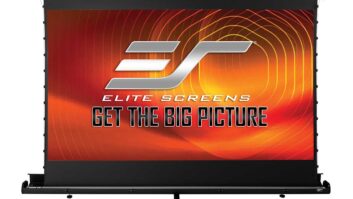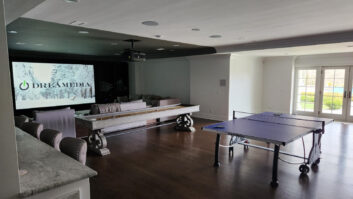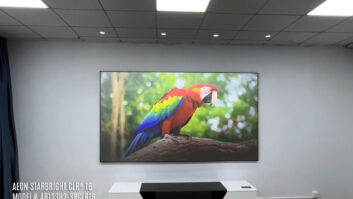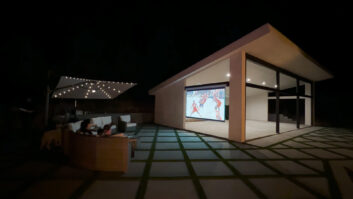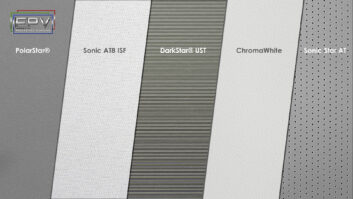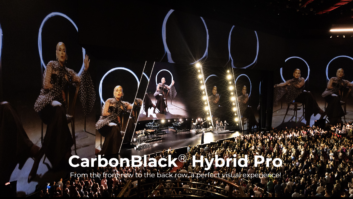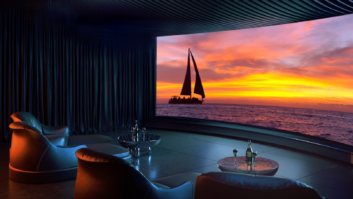Never get too comfortable with a “K.” Just when we’ve heard enough about 4K, and ample content starts flowing, when we find out that it is really just a stepping stone to something even better — 8K! And if you are talking about the finest in video quality, then you know you are talking about high-end home theater projectors — a few of which are ready for the eventual 8K revolution and others that are working to perfect 4K.
Here we take a look at some current additions to projector lines — and the latest in the screens they project onto.
Projectors
While 8K is the goal, how they get there is handled differently by different manufacturers. JVC, for example, uses their 8K e-shift technology in their top-of-the-line D-ILA models, the DLA-NX9 and DLA-RS3000. The entire D-ILA line is 4K ready, but the e-shift technology works together with the native 4K D-ILA devices to produce an 8K image on the screen. Higher quality images are also achieved, according to JVC, with their own Multiple Pixel Control high-resolution technology, which converts full HD and 4K images to high-definition 8K images.

The DLA-NX9 and DLA-RS-3000 are also equipped with a high-resolution 18-element, 16-group all-glass lens with full aluminum lens barrel. A 100mm diameter lens provides a wide shift range of ±100 percent vertical and ±43 percent horizontal. In addition, five low-dispersion lenses that account for the different refractive index of red, green, and blue have been adopted to suppress chromatic aberration, bleeding, and other anomalies.
At this past CEDIA Expo, DPI turned heads and widened eyes with a demonstration on their flagship Insight Laser 8K projector. Providing a resolution of 7680 x 4320 pixels through 25,000 lumens of solid-state laser-phosphor illumination, the Insight Laser 8K will more likely find use in commercial applications, but could make its way into the home theater of a very serious client.

The projector uses DLP technology, and colors and blacks are enhanced by the 3 x 1.38-inch DarkChip DMD and DP’s ColorMax technology. Lamp replacements are never required due to the Insight Laser 8K’s solid-state laser illumination system. By eliminating regular lamp replacement cycles, system operation is never interrupted, and with its filterless design, long-term maintenance cost is near zero, leading to a much lower cost of ownership over the lifespan of the projector. DPI is confident enough in that fact to have their warranty also cover the light source for the same term as every other component in the projector.
It’s not all about 8K. Barco’s Prometheus III projector, for example, goes all in on its 4K performance. Designed for high-end home theaters, it features the company’s Alchemy Integrated Cinema Media Processor, which offers DCI compliance to enable playback of true DCI cinema content, and HDMI 2.0a and HDCP 2.2 to support 4K UHD Blu-ray, gaming consoles, and other media devices. Barco Alchemy enables 4K 2D content at 60 fps and 4K 3D at 30 fps.
Another model in the 4K camp, Epson’s Pro Cinema 4050 projector leverages Epson’s new 4K PRO-UHD technology, which features an improved version of the company’s pixel-shifting, resolution-enhancement technology, along with an expansive color gamut, high dynamic range, and 100 percent balanced color brightness.

According to Epson, their 4K PRO-UHD technology features an advanced, high performance optical engine that generates high color brightness and white brightness, color accuracy, and dramatic contrast with HDR10. Spec-wise the 4050 provides 2400 lumens, contrast ratio up to 200,000:1, and HDR10.
It also features a 15-element glass projection lens that uses a three-axis precision motor for powered focus, 2.1x zoom, up to ±96 percent horizontal and up to ± 47 percent vertical lens shift, and 10 preset positions.
The BenQ HT9060 4K UHD HDR projector balances the wide-gamut high-brightness output of Philips ColorSpark HLD LEDs with BenQ’s CinematicColor technology to, as the company states, accurately produce the DCI-P3 color space and perfectly match the authentic digital cinema color performance.

With 8.3 million distinct pixels and 1.07 billion colors, it fully meets Consumer Technology Association’s (CTA) 4K UHD specification. It features 2200 lumens of brightness, a 50,000:1 dynamic contrast ratio, and has HDR10 and HLG support.
The projector is equipped with ±27 percent horizontal ±65 percent vertical lens-shifting. Dealers can take advantage of ISFccc certification to facilitate installation. For true cinephiles, an optional Panamorph Paladin anamorphic lens delivers the 2.4:1 aspect ratio of commercial cinemas without letterboxing, providing 2 million more pixels for increased brightness and detail.
Just introduced at CES, the Optoma P1 Smart 4K UHD Laser Cinema is an all-in-one smart home entertainment system that integrates a 4K ultra high definition (UHD) home theater projector, featuring Amazon Alexa and Google Assistant voice control capabilities with an ultra short throw distance, and an integrated premium NuForce soundbar with Dolby Digital 2.0 support. The P1 delivers a 3000-lumen, 8.3-million-pixel image on screen, and allows viewers to project up to a 120-inch image. It also has HDR10 and HLG (Hybrid Log Gamma) compatibility.

The integrated soundbar is designed by NuForce, and is built with individual woofers, as well as aluminum full-range drivers and isolated speaker enclosures for low distortion. The NuForce integrated soundbar offers Dolby Digital, Dolby Digital Plus, and DTS audio decoding capabilities. The Optoma P1 will be available in late Q2 for an expected street price of $2999.
Related: Tech Tip: Know When to Sell What Projector with Which Screen
Screens
Not to be outdone, screen manufacturers continue to up the ante on their product offerings. For example, the EPV Screens AcousticPro 4K eFinity Series is an acoustically transparent EDGE FREE fixed frame screen that features an ultra-thin bezel design that reduces the overall footprint and maximizes the viewing area.

The screen itself is made of EPV’s AcousticPro 4K front projection material, which has a sheer weave design specifically crafted to improve both audio and visual performance. It reduces light loss while allowing sound to pass through the screen with minimal attenuation. The tight angled perforations negate the formation of moiré effect, which is found on some sound transparent screen materials.
Stewart Filmscreen recently redesigned their Director’s Choice four-way masking screen to increase the screen size with less visible masking — reducing the frame by up to 75 percent. Director’s Choice accommodates the different shapes and sizes of today’s content by automatically adjusting aspect ratios using four-way variable masking that eliminates vertical and horizontal black bars around the image. It is available in multiple finishes and screen materials.

The Parallax 2.3 screen from Da-Lite focuses on ambient light rejection (ALR), being made up of micro-layers to achieve 96 percent ambient light blocking properties and a viewing cone of 46 degrees. The result is, according to the company, a bright, colorful image without glare — regardless of how much light is in the room.
Also thinking about ALR, Screen Innovations (SI) has made its ambient-light-rejecting Short Throw (ST) screen material available on their Solo Pro family of customizable motorized screens. Short Throw, which uses a microscopic lenticular optical technology, is best suited for ultra-short throw projection applications where the projector is located directly below the screen at throw ratios as close as 0.1 times the image width. According to SI, this technology can successfully reproduce 8K resolution while rejecting up to 90 percent of the ambient-light in the room.

Want more ALR? Severtson Screens has new ALR options for their Impression Series projection screens. Severton’s ALR has a 170-degree viewing angle and is available up to 120 inches (diagonal at 16:9), with custom options also now available.

Want more stories like this delivered to your inbox every day? Then sign up for the free Residential Systems eNewsletter here.
